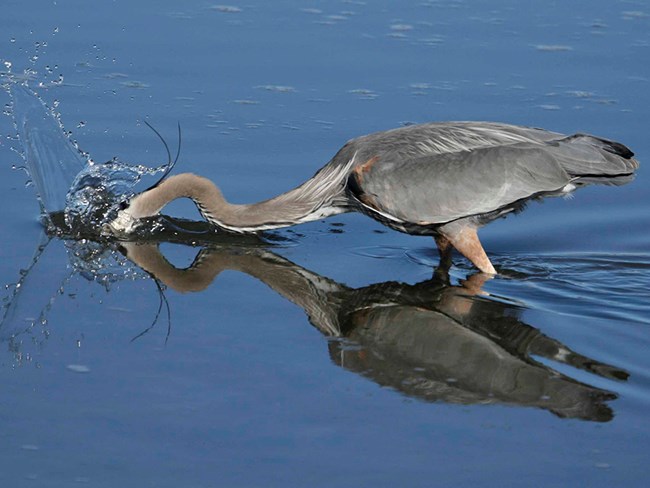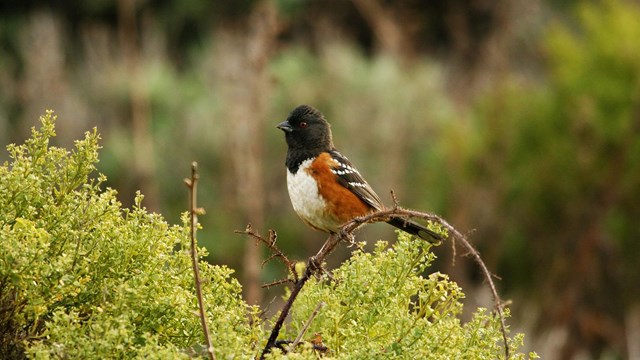
NPS Photo: Kirke Wrench. Birdwatching Paradise: The Abundant Avian Life of Golden GateThe most visible wildlife in Golden Gate are definitely the birds. You will see them rustling in the bushes near a path, soaring overhead, or floating across a marsh. An astonishing number of avian species live in or migrate through Golden Gate's Diverse Landbird SpeciesWith its variety of riparian habitat and position along a major migratory pathway, Golden Gate hosts some of the largest and most diverse assemblages of landbirds in the United States. Park creeks attract neotropical migrants: small songbirds making their way up and down the coast each fall and spring. Along Redwood, Lagunitas, and Lobos Creeks riparian songbirds such as olive-sided flycatchers, Swainson’s thrush, 
NPS / Will Elder Waterbirds and ShorebirdsThe precipitous cliffs and offshore rocks that flank the park are a haven for colonial seabirds. Bird Island off of Rodeo Lagoon is one of the largest roosting sites in northern California for the endangered brown pelican, with several hundred making a splash in Rodeo Lagoon each Fall. Brandt’s cormorants nest at Lobos Rocks and Seal Rocks along Land’s End in San Francisco, turning the rocks bright white with their strong-smelling guano. Pelagic cormorants nest in very small colonies on steep cliffs and sea stacks from the Golden Gate north to Stinson Beach. Peregrine falcons are seen in their kamikaze dive, foraging along the coastal cliffs and have nested from the Golden Gate Bridge north to Muir Beach. Colonial nesting waterbirds have found not a prison on Alcatraz Island, but inviting habitat in which to nest during the Spring and Summer months. In one of the most internationally visible settings within the National Park Sysytem, Alcatraz supports black-crowned night-herons, Brandt’s cormorants, pelagic cormorants, and pigeon guillemots—the only colonies found in San Francisco Bay for these species. Most colonial nesting waterbirds breed on offshore islands. The island’s large western gull colony represents a significant portion of its coastal breeding population in northern California. Sandy beaches and mucky estuaries provide important habitat for migrating and wintering waterbirds and shorebirds. Tomales Bay, Bolinas Lagoon, Stinson Beach, Muir Beach, Big Lagoon, Rodeo Lagoon, Crissy Field and Ocean Beach, provide habitat for loons, grebes, scoters, numerous species of dabbling and diving ducks, gulls, terns, willets, sanderlings, and sandpipers. Federally threatened western snowy plovers overwinter at Ocean Beach and Crissy Field Marsh. The park's mudflats provide plenty of tasty invertebrates, and estuaries provide fish and crabs galore. The San Francisco Bay is an important stopover for migrating species both due to its size and diversity of suitable habitat. Nearshore marine waters just outside the Golden Gate also provide foraging sooty shearwaters and pigeon guillemot, with thousands of birds rafting together on open water. 
NPS / Will Elder The PresidioAn island of green in an urban matrix, the Presidio’s location on the northwest tip of the San Francisco peninsula offers a stopover location to many birds before crossing the Golden Gate Straights, or as an entrance gate to the rich wetlands of the San Francisco Bay. Native habitats and introduced forest are regionally important to locally declining species such as the California quail, western screech owl, wrentit, and Hutton’s vireo. The landscaped areas of the Presidio also attract some interesting birds. The hooded oriole reaches the northern limit of its breeding range in the Presidio due to the royal palms planted throughout this former Army Post. Explore birds of the Presidio of San Francisco. Muir WoodsThe old growth forest of Muir Woods represents a fragmented island of the redwood stands that existed 150 years ago. Muir woods is now the last remaining contiguous stand of old growth coast redwoods in Marin County. Underneath the dappled sunlight, high in the branches of these giants, federally threatened species such as the northern spotted owl nests. Marin County is home for a fairly large population of these small owls that have found themselves spotlighted in the media. At least 69 bird species occur within Muir Woods, the majority of which are small neotropical migrants such as the Pacific-slope flycatcher, winter wren, golden-crowned kinglet, and chestnut-backed chickadee. Marin Headlands
Learn More

Pacific Coast Science & Learning Center
Browse more resources on birds in San Francisco Bay Area parks. 
Landbird Monitoring
Learn more about the San Francisco Bay Area Network's Landbird Monitoring program. |
Last updated: September 10, 2024



